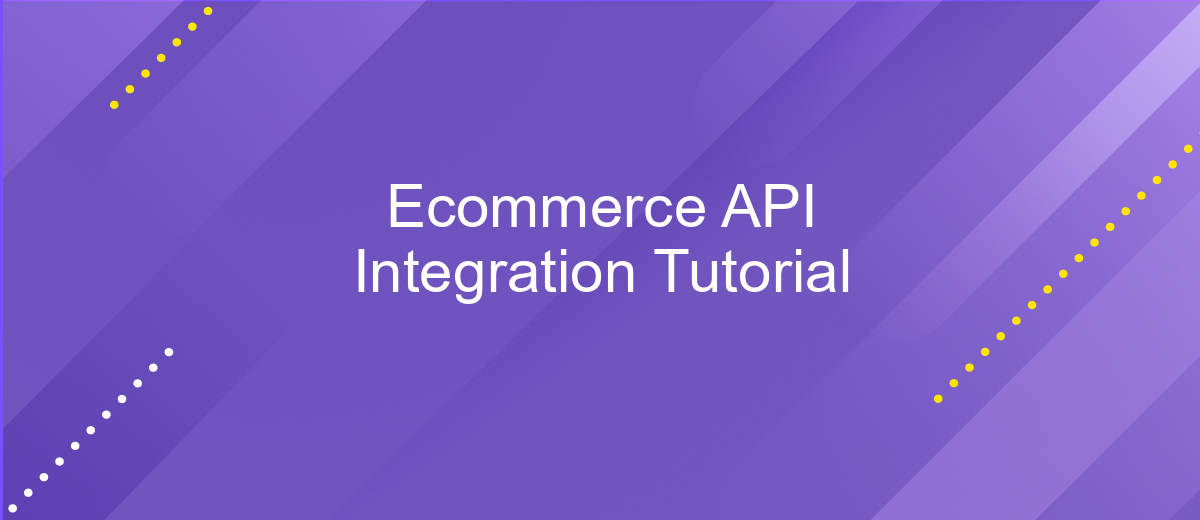Ecommerce API Integration Tutorial
In today's digital marketplace, seamless ecommerce operations are essential for success. Integrating APIs into your ecommerce platform can significantly enhance functionality, streamline processes, and improve user experience. This tutorial will guide you through the steps of ecommerce API integration, providing you with the necessary tools and knowledge to connect various services and optimize your online store for better performance and customer satisfaction.
Introduction to Ecommerce API Integration
In today's rapidly evolving digital landscape, ecommerce businesses must adapt to stay competitive. One essential component of this adaptation is the integration of Application Programming Interfaces (APIs) into ecommerce platforms. APIs enable seamless communication between different software systems, enhancing functionality and improving user experiences. By integrating APIs, ecommerce businesses can streamline operations, offer personalized services, and expand their reach to new markets.
- Facilitates real-time data exchange between systems
- Enhances customer experience by offering personalized services
- Enables automation of routine tasks, saving time and resources
- Supports scalability by allowing easy addition of new features
- Improves security by providing controlled access to data
Despite the clear benefits, integrating APIs into ecommerce systems can be complex. It requires careful planning and execution to ensure compatibility and security. Businesses must choose the right APIs that align with their goals and infrastructure. Furthermore, regular maintenance and updates are essential to keep the integration running smoothly. By understanding the intricacies of API integration, businesses can unlock new opportunities and drive growth in the competitive ecommerce landscape.
Choosing the Right Ecommerce API

Choosing the right ecommerce API is crucial for seamless integration and functionality. When selecting an API, consider factors such as compatibility with your existing systems, ease of use, and the breadth of features it offers. A comprehensive API should support various ecommerce operations like inventory management, order processing, and customer data handling. Evaluate the API documentation for clarity and thoroughness, as well as the availability of developer support and community forums.
Additionally, consider leveraging integration platforms like ApiX-Drive, which simplify the process of connecting your ecommerce platform with other applications. ApiX-Drive offers a user-friendly interface and supports a wide range of integrations, reducing the technical burden on your team. This service can be particularly beneficial if you need to connect multiple systems or automate complex workflows without extensive coding. By carefully assessing your business needs and the capabilities of the API, you can ensure a successful ecommerce integration that enhances your operational efficiency and customer experience.
Authentication and Authorization

In the realm of Ecommerce API integration, authentication and authorization are critical components to ensure secure data exchange. Authentication verifies the identity of the user or system trying to access the API, while authorization determines what resources they can access. Implementing these mechanisms effectively is essential for maintaining data integrity and security.
- Choose an Authentication Method: Select a suitable method such as API keys, OAuth, or JWT based on your security requirements and ease of implementation.
- Implement Secure Token Storage: Store tokens securely using encryption techniques to prevent unauthorized access.
- Define Access Scopes: Clearly define access scopes to ensure users have the minimum permissions necessary to perform their tasks.
By following these steps, you can establish a robust authentication and authorization framework for your Ecommerce API integration. This not only protects sensitive customer data but also enhances the overall trustworthiness of your platform. Regularly reviewing and updating your security practices is essential to adapt to evolving threats and maintain a secure environment.
Implementing Core API Functionality

Implementing core API functionality is crucial for seamless eCommerce operations. It involves setting up endpoints that allow for efficient communication between different software systems. By doing so, businesses can automate processes such as order management, inventory tracking, and customer service, enhancing overall efficiency.
To begin, developers must first identify the primary functions the API should support. This includes analyzing business needs and determining how the API can meet those requirements. Once the core functionalities are defined, the next step is to design the API architecture, ensuring it is scalable and secure.
- Define API endpoints for product listing and management.
- Set up authentication mechanisms for secure access.
- Implement data validation to ensure data integrity.
- Develop error handling protocols to manage exceptions.
After implementing these core functionalities, rigorous testing is essential to ensure the API performs as expected under various conditions. This involves both unit tests and integration tests to verify that all components work harmoniously. Once testing is complete, the API can be deployed, enabling enhanced eCommerce capabilities and improved user experiences.


Testing and Deployment
Testing your Ecommerce API integration is a crucial step to ensure seamless functionality and reliability. Begin by setting up a dedicated testing environment that mirrors your production setup. This allows you to identify and rectify potential issues without affecting live operations. Employ automated testing tools to simulate various scenarios, ensuring that the API handles requests and responses correctly. Additionally, consider using ApiX-Drive to streamline the testing process. This service provides a user-friendly interface for managing and testing integrations, allowing you to quickly identify and resolve any discrepancies.
Once testing is complete, focus on deploying your integration. Start by deploying to a staging environment to validate the integration in a controlled setting. Monitor the performance and address any last-minute issues that arise. After successful staging, proceed with the production deployment. Ensure you have a rollback plan in place to mitigate any unforeseen problems. Throughout the deployment, maintain clear communication with your team and stakeholders, ensuring everyone is informed of progress and potential impacts. This structured approach to testing and deployment will help guarantee a smooth and successful integration.
FAQ
What is an Ecommerce API Integration?
How do I start integrating APIs into my ecommerce platform?
What are the benefits of using APIs for ecommerce?
How can I ensure the security of my ecommerce API integration?
Can I automate ecommerce processes without extensive coding knowledge?
Apix-Drive will help optimize business processes, save you from a lot of routine tasks and unnecessary costs for automation, attracting additional specialists. Try setting up a free test connection with ApiX-Drive and see for yourself. Now you have to think about where to invest the freed time and money!

